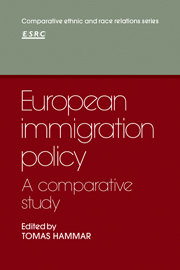4 - Great Britain
Published online by Cambridge University Press: 05 November 2011
Summary
Immigration and immigration policy
Britain has traditionally been a country of emigration. Since the eighteenth century considerable numbers of Britons have moved overseas and helped establish and populate the United States and countries of the British Commonwealth and Empire. During the nineteenth century the majority of migrants went to the USA, but after 1900 most emigrated to Canada, Australia, and other Commonwealth countries. By the turn of the century migration had become a conscious part of British imperial policy, and it was felt that encouraging emigration from Britain to the Commonwealth would help the economic development of Dominion territories, strengthen the ties with Britain, and increase the power of the Empire. Land grants and assisted passages were used to encourage people to migrate. After the First World War the self-governing Dominions became more selective in their demands for migrants, requiring skilled industrial workers instead of agricultural workers. There was no halt in the outward flow, however, and between 1919 and 1930 two million people emigrated from the United Kingdom.
The depression between the wars caused a change in the balance of migration and the net flow became an inward one. After the Second World War, however, emigration resumed at a high level, encouraged particularly by the immigration policies of Australia, which was concerned to increase her population for security reasons and also to maintain its British character. Between 1946 and 1950 720,260 people left the UK, and most of them were relatively highly skilled (Cheetham 1972).
- Type
- Chapter
- Information
- European Immigration PolicyA Comparative Study, pp. 89 - 126Publisher: Cambridge University PressPrint publication year: 1985
- 8
- Cited by



